|
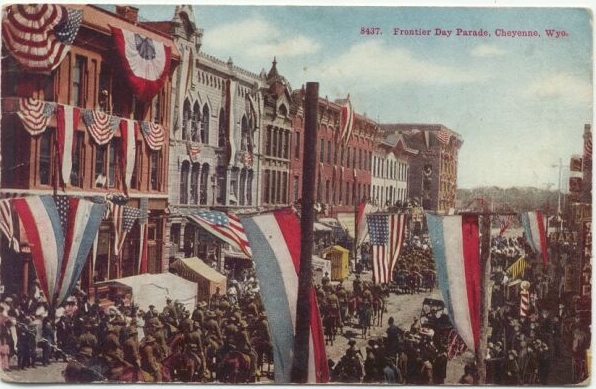
Cavalry from Fort D. A. Russell, Frontier
Day Parade, 1910.
The troops from Fort D. A. Russell have participated in Frontier Days from the very beginning. The parade
has, as indicated by the following photos, been an important feature of the celebration from
the beginning.
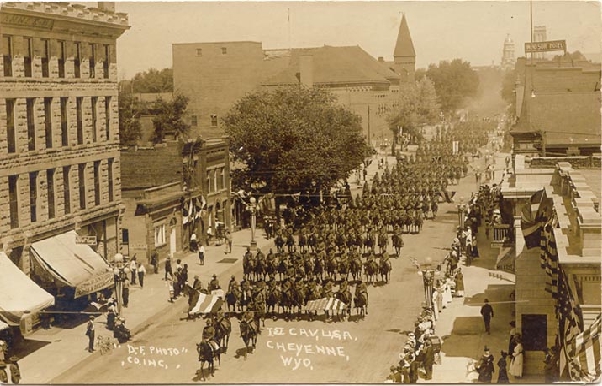
1st Cavalry from Fort D. A. Russell, Frontier
Day Parade, Capital Avenue, approx. 1910.
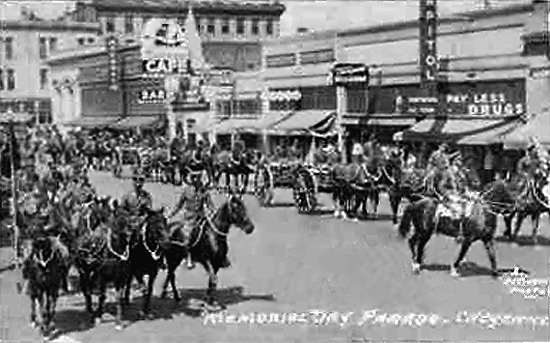
76th Field Artillery from Fort F.E. Warren, Memorial
Day Parade, 17th Street, 1937 Photo by A. E. Gordon.
The 76th Field Artillery when battery "A" fired off the cannon to signal the start of the
first show.
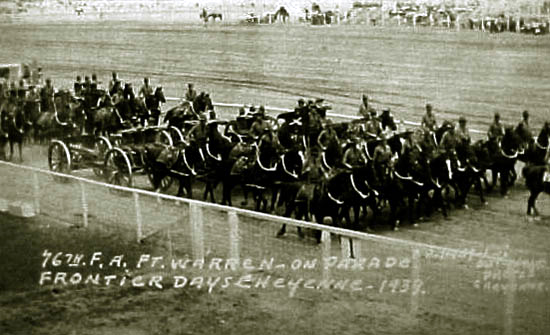
76th Field Artillery Frontier Park, 1939. Photo by A. E. Gordon.
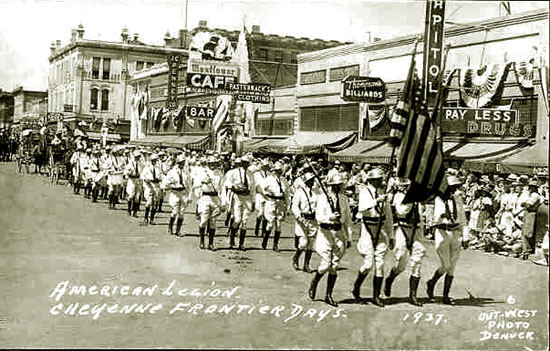
American Legion, Frontier
Day Parade, 17th Street, 1937 Photo by A. E. Gordon.
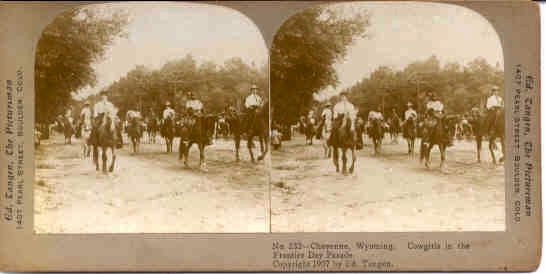
Cowgirls in Frontier Day Parade, stereograph by Ed Tangen, 1907.
For discussion of Ed Tangen, see previous page.
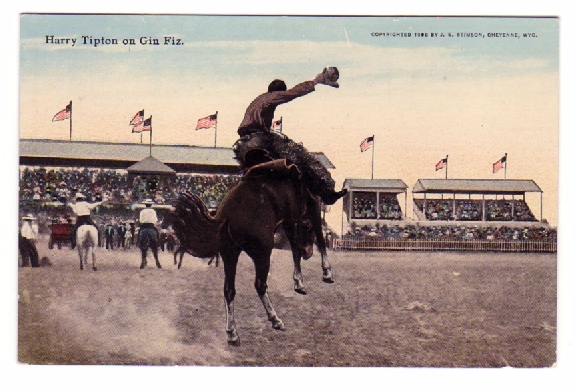
Harry Tipton on Gin Fiz, 1908, photo by
J. E. Stimson.
Gin Fiz was one of C. B. Irwin's horses. In many instances, the horses were a bigger attraction than the riders. Thus, in the caption for the
Harry Tipton postcard above, Stinson writes only of Gin Fiz and nothing of
Tipton:
HARRY TIPTON ON "GIN FIZ":
This is an exceptionally bad actor, and is considered one of the best performers. He is
known as a high bucker from start to finish, usually landing his rider before exhausting his different
stunts.
Each "OutLaw" has some peculiar un-taught action; all its own forming an interesting study and
an exiting exhibition.
The Official Program
(as published by a local restaurant)
for the third day of the 1908 Frontier Days celebration listed the events and prizes. Events were designed to
appeal to all tastes. It was not necessarily politically correct, discriminating in the prizes given
to Native Americans and featuring such events as
a "Squaw Race" and "Wolf Roping":
Event No. 1 - Spectacular Galloping Parade of 1000 Cowboys and Cowgirls.
Event No. 2 - Cow Pony Race. One-half Mile. 1st, $40; 2nd $25; 3rd $10.
Event No. 3 - Indian Pony Race. One-half mile: 1st $10, 2nd $7, 3rd $3.
Event No. 4 - Exhibition of Fancy Shooting by Capt. [A. H.] Hardy, champion of the world.
Event No. 5 - One Mile 1st: $120,; 2nd $60; 3rd $20. Free for All
Event No. 6 - Steer Roping.
Event No. 7 - Attack and Burning of Fontier Cabin By Indians, repulse cowboys.
Event No. 8 - Ladies Cowpony Race, 1st $45; 2nd $20; 3rd $10.
Event No. 9 - Exhibition Drill by U.S. troops from Camp Crawford.
Event No. 10 - Indian War Dance.
Event No. 11 - Exhibition of Hitching and Driving a Wild Horse. 1st, $40; 2nd $25; 3rd $10.
Event No. 12 - Squaw Race, One-Half Mile, 1st $10; 2nd $7; 3rd $3.
Event No. 13 - Denver Post Ladies' Race. Purse, $300 and $200 cup. 1st $150 and cup; 2nd, $100; 3rd $50.
Event No. 14 - Steer Roping Contest, 1st $240; 2nd $90; 3rd, $50; 4th, $20.
Event No. 15 - Bucking Contest.
For World's Championship. 1st, $75 and $250 saddle; 2nd, $75; 3rd, $70;
4th, $60; 5th, $50; 6th, $40. To owner of worst horse, $25.
Event No. 16 - Wolf Roping. Free for All.
Event No. 17 - Wild Horse Race. Half-mile Dash. 1st $75; 2nd $25; 3rd, $15; 4th, $10.
Event No. 18 - Supper at KABIS' CAFE.
Opppsite the U.P Depot.
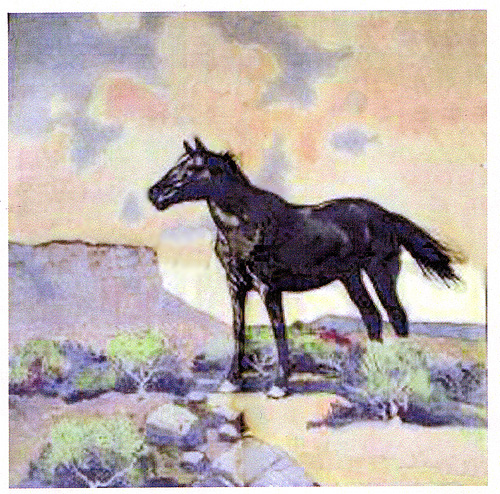
Midnight
The horses, themselves were the stars of the show. In addition to
Steamboat featured on the previous page, one of the most famous of rodeo
bucking horses was Midnight (c. 1910-1934).
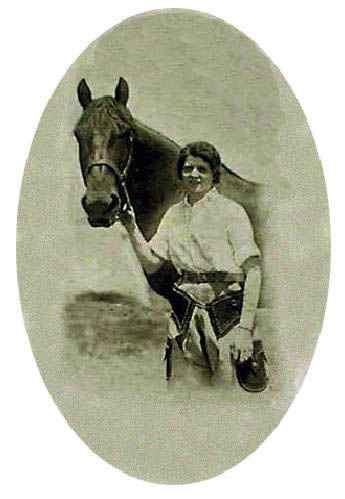 Midnight with Jean Nimmo Dubois, Miss Frontier, 1931
Midnight with Jean Nimmo Dubois, Miss Frontier, 1931
Midnight was on the rodeo circuit
from 1923 until 1933. Midnight was mixed
throroughbred, morgan and percheron and at his peak weighed 1300 lbs. He had been discovered by Alberta ranchman, Jim McNab when he and his top
hand were both thrown by the horse. Midnight's fame was such that when Denver's National Western Stock
Show added a rodeo in 1931, the star attraction was Midnight. Midnight threw all who tried to ride him. The
first, a cowboy movie star, was thrown on the first jump. The exact number of men
who succeeded in riding Midnight may never be known. The first to ride Midnight was Pete Bruised Head,
a Canadian Indian, who rode the horse at Fort Macleod, Alberta. But then it was not
an "approved" rodeo. Thus, credit for the first ride is general given to World Champion Pete Knight.
Midnight retired to Platteville, Colorado, and died in 1936. At the 1937 Denver Stock show,
the crowd stood for a minute of silence in tribute to Midnight.
A life-size bronze statue has been erected in
Midnight's honor in front of the Amon G. Carter Jr. Exhibits Hall in Fort Worth. Midnight
died in 1934. He is buried at the National Cowboy Hall of Fame. Midnight's grave marker reads:
Under this sod
lies a great bucking hoss;
There never lived
A cowboy he counln't toss.
His name was Midnight,
His coast as black as coal,
if there is a hoss-heaven,
Please God, rest his soul. |
Miss Dubois was the first "Miss Frontier. Selection was made by the number of tickets sold
by her sponsoring organization, the Cheyenne Post of the American Legion.
Midnight and another famous horse, Five Minutes to Midnight (1924-1947), also from
Canada, were owned by Vern Elliott and Ed McCarty who are discussed
on a subsequent page.
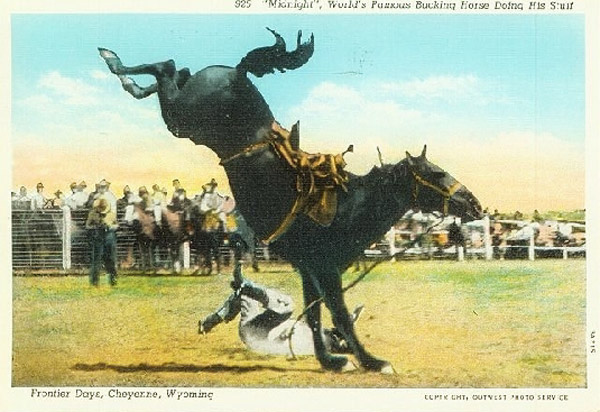
Midnight throwing Carl Beasley, Frontier Days. Photo by
Out West Photo Service.
"Out West Photo Service" shown on the above photo was owned by Adlai Edgerton "A. E." Gordon, the photographer
in the left background. Gordon did
extensive rodeo photos in the 1920's, 30's, and 40's. He had studios in both Cheyenne and Denver. The
Cheyenne studio was on Capitol Avenue.
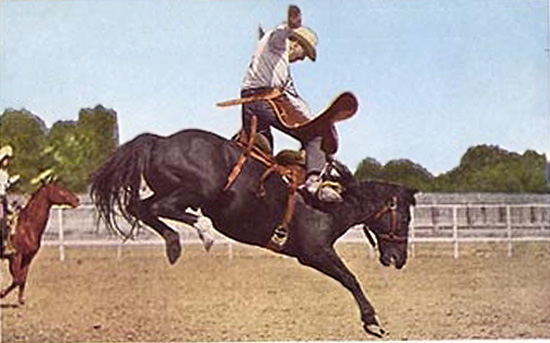
Five Minutes to Midnight.
Five Minutes to Midnight, also originally from Alberta, was originally named Tumbling Mustard. His name was allegedly
changed as a result of being slightly smaller than Midnight, only 900 lbs. Five Minutes to
Midnight reired in 1946 and died in 1947.
Next page: Frontier Days continued.
|